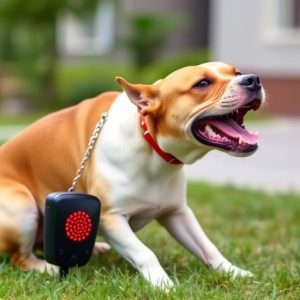Mastering Sonic Defense: Optimal Placement of Ultrasonic Repellers
Ultrasonic repeller devices are humane animal control tools that emit inaudible sounds to deter rode…….
Ultrasonic repeller devices are humane animal control tools that emit inaudible sounds to deter rodents, cats, dogs, and birds. For optimal results, place them near entry points like windowsills and doors, moving them regularly to prevent habituation. Strategically position them along fences or walls for maximum efficacy, avoiding high-traffic human areas. The best placement depends on the target species and area, with indoor spaces requiring strategic positioning near entry points and outdoor areas needing perimeter placement. These devices create an uncomfortable environment for animals without causing harm, but their range limitations may require additional measures for comprehensive control.
“Discover the power of animal control sonic defense tools—a innovative, non-lethal solution for managing pests. This comprehensive guide explores how ultrasonic repeller devices emit high-frequency sound waves to deter animals, offering a safe and effective approach to wildlife management. Learn about optimal placement strategies for maximum effectiveness, animal sensitivity to ultrasound, benefits, limitations, and real-world success stories. Find out why these tools are becoming a preferred method for maintaining harmony between humans and wildlife.”
- Understanding Ultrasonic Repeller Devices: How They Work
- Best Placement Strategies for Maximum Effectiveness
- Common Animals and Their Sensitivity to Ultrasound
- Benefits and Limitations of Using Sonic Defense Tools
- Case Studies: Successful Implementation in Various Environments
Understanding Ultrasonic Repeller Devices: How They Work
Ultrasonic repeller devices are innovative tools designed to deter animals through sound waves, offering a humane and eco-friendly solution for animal control. These devices emit high-frequency sound signals that are inaudible to humans but irritating to animals like rodents, cats, dogs, and birds. The technology is based on the principle that these sounds disrupt an animal’s senses, causing them to feel discomfort or even fear, prompting them to leave the area.
The best placement for ultrasonic repeller devices is often near entry points, such as windowsills, doors, or any places where animals are likely to enter. Strategically positioning the devices can create a protective barrier around your home or property, preventing animals from settling in or causing damage. Regular movement of these devices across different areas can also enhance their effectiveness by ensuring animals do not become accustomed to a single frequency.
Best Placement Strategies for Maximum Effectiveness
To maximize the effectiveness of ultrasonic repeller devices, strategic placement is key. Positioning these tools in areas where animals are known to congregate or attempt to enter is essential. For outdoor use, place them along fences, walls, or other barriers that serve as potential entry points for pests like rodents, cats, or dogs. The consistent sound emitted by these devices creates an uncomfortable environment for these creatures, deterring them from approaching.
For optimal results, avoid placing ultrasonic repellers in areas where humans frequent frequently, as the high-frequency sounds might be disturbing. Instead, focus on locations that are more remote or less accessible to ensure both animal control and human comfort. Regularly changing the placement can also help maintain their effectiveness, as animals may become accustomed to a single location over time.
Common Animals and Their Sensitivity to Ultrasound
Many animals, both wild and domestic, are sensitive to ultrasound frequencies, making ultrasonic repellers an effective tool for animal control. Cats, dogs, birds, rodents, and even insects like mosquitoes have been shown to react negatively to high-frequency sound waves. This is because these animals possess specialized hearing mechanisms that can detect and locate high-pitched sounds not audible to humans.
When it comes to deploying ultrasonic repeller devices, the best placement depends on the target animal species and the area to be protected. For indoor spaces, strategically placing devices near entry points, such as windows and doors, can deter birds and insects from entering. In outdoor settings, positioning them around perimeters or in specific problem areas can help keep cats, dogs, and rodents at bay. Ensuring proper coverage while avoiding areas where humans spend significant time is key to effective and safe use.
Benefits and Limitations of Using Sonic Defense Tools
Sonic defense tools, particularly ultrasonic repeller devices, offer a non-lethal and humane approach to animal control. One of their key benefits is their ability to deter animals like rodents, birds, and insects without causing them harm. These devices emit high-frequency sound waves that are inaudible to humans but uncomfortable for many animals, encouraging them to seek alternative habitats. They’re especially useful in areas where traditional traps or poisons aren’t feasible or preferred, such as homes, gardens, and sensitive environments.
However, there are limitations to consider. Not all animals are affected equally by ultrasonic waves; some may simply learn to ignore the sound. Additionally, these devices have a range limitation, requiring strategic placement for maximum effectiveness. They might not be suitable for large areas or dense populations of animals. Moreover, while they’re effective against specific pests, they won’t address deeper-rooted behavioral issues that may require additional animal control measures. The best placement for ultrasonic repeller devices is in strategic locations where animals are most likely to enter, such as entry points, windowsills, and near trash cans, ensuring a thorough but targeted coverage area.
Case Studies: Successful Implementation in Various Environments
In various real-world scenarios, animal control ultrasonic defense tools have proven to be highly effective. Case studies show that these devices are particularly successful when strategically placed in areas where wildlife intrusion is a problem. For instance, in urban settings, they’ve been deployed along fences surrounding residential properties, parks, and commercial spaces, effectively deterring animals like raccoons, cats, and dogs from entering. This placement takes advantage of the device’s ability to emit high-frequency sound waves that are unpleasant for targeted species but harmless to humans and pets.
In more natural environments, such as farms and ranches, these ultrasonic repellers have been used to protect crops and livestock from wildlife like foxes, rabbits, and birds. Farmers report significant reductions in crop damage and improvements in animal welfare when the devices are placed near fields and barns. Best placement for ultrasonic repeller devices is often along perimeters where animals tend to enter, taking into account factors like terrain, wind patterns, and common animal pathways.
Ultrasonic repeller devices, with their ability to emit high-frequency sound waves, offer a unique and non-lethal approach to animal control. By understanding how these tools work and implementing the best placement strategies, such as targeting specific areas where animals tend to gather or nest, users can achieve maximum effectiveness. The sensitivity of various animals to ultrasound varies, with rodents and birds being particularly susceptible, making these devices ideal for urban environments and farms. While benefits include humane deterrence, quiet operation, and minimal environmental impact, limitations like potential ineffectiveness against larger mammals and the need for consistent power sources should be considered. Successful case studies demonstrate the versatility of ultrasonic repeller devices across different settings, solidifying their role as a valuable tool in managing wildlife interactions.


